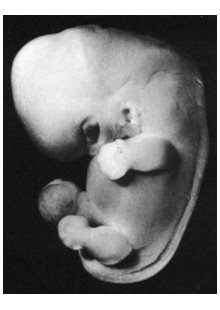The Stages of Human Embryonic Development
Stage 18 embryos have a greatest length between 13 and 17 mm and an estimated postfertilization age of approximately 44 days. Many structures become apparent for the first time during this stage. In the head region the tip of the nose becomes discernable as well as the volmeronasal organ, eyelids, and nasolacrimal ducts. The phallus and genital tubercle (glans penis or glans clitoris) are evident for the first time.
The auricular hillocks begin to blend to form parts of the definitive external ear. Two or three semicircular ducts form from the otic vesicle in the otic capsule. The oronasal membrane breaks down leaving behind the choanae through which the nasal cavity will communicate with the pharynx. The subarachnoid space surrounds the entire central nervous system and the choroid plexus is forming in the roof of the 4th ventricle. The adenohypophyseal pouch is closed ending below as a stem.
Mammary glands appears in the surface ectoderm on the side of the thorax. Metacarpals are evident as rays of precartilage condensations, or cartilage, in the hand plate and intermetacarpal notches are present at the periphery of the plate. Similarly, metatarsals appear as rays of precartilage condensations or cartilage in the foot plate with intermetatarsal notches at the periphery of the foot plate. Many individual muscles and cartilages that were earlier blastema can now be identified. Internally, the second interatrial septum and foramen ovale can be identified in the heart and the left postcardinal vein near the heart has disappeared with its distal portion draining into the newly formed inferior vena cava. Tertiary segmental bronchi are distinct in the lung and the muscular part of the diaphragm is forming at the periphery of the septum transversum. The paramesonephric duct begins to form along the lateral side of the cephalic part of the mesonephros.
| Browse the section images |
| 3D reconstructions |
| More info ... |
